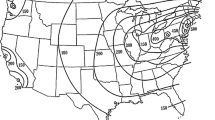Abstract
In this paper, we propose the normalized revealed comparative advantage (NRCA) index as an alternative measure of comparative advantage. The NRCA index is demonstrated capable of revealing the extent of comparative advantage that a country has in a commodity more precisely and consistently than other alternative RCA indices in the literature. As a result, the NRCA index is comparable across commodity, country, and time. Therefore, the NRCA index provides a useful tool for quantitative regional research, especially for studies on regional comparative advantage.
Similar content being viewed by others
References
Balassa B (1965) Trade liberalisation and revealed comparative advantage. Manch Sch Econ Soc Sci 33: 99–123
Ballance R, Forstner H, Murray T (1985) On measuring revealed comparative advantage: a note on Bowen’s indices. Weltwirtschaftliches Arch 121: 346–350
Ballance R, Forstner H, Murray T (1986) More on measuring comparative advantage: a reply. Weltwirtschaftliches Arch 122: 375–378
Benedictis LD, Tamberi M (2001) A note on the Balassa index of revealed comparative advantage. Working Papers #158, Dipartimento di Economia, Universita’ Politecnica delle Marche (I), doi:10.2139/ssrn.289602
Bojnec S (2001) Trade and revealed comparative advantage measures: regional and central and east European agricultural trade. Eastern Eur Econ 39: 72–98
Bowen HP (1983) On the theoretical interpretation of indices of trade intensity and revealed comparative advantage. Weltwirtschaftliches Arch 119: 464–472
Bowen HP (1985) On measuring comparative advantage: a reply and extension. Weltwirtschaftliches Arch 121: 351–354
Bowen HP (1986) On measuring comparative advantage: further comments. Weltwirtschaftliches Arch 122: 379–381
Cai JN, Leung PS (2007) Toward a more general measure of revealed comparative advantage variation. Appl Econ Lett 1–4. doi:10.1080/13504850600748992
Cai JN, Leung PS, Loke M (2007) Comparative advantage of selected agricultural products in Hawaii: a revealed comparative advantage assessment. Economic Issues EI-11, College of Tropical Agriculture and Human Resources, University of Hawaii at Manoa
Dalum B, Laursen K, Villumsen G (1998) Structural change in OECD export specialisation patterns: de-specialisation and stickiness. Int Rev Appl Econ 12: 447–467
Deardorff A (1994) Exploring the limits of comparative advantage. Weltwirtschaftliches Archiv 130: 1–19
Havrila I, Gunawardana P (2003) Analyzing comparative advantage and competitiveness: an application to Australia’s textile and clothing industries. Aust Econ Pap 42: 103–117
Hiley M (1999) The dynamics of changing comparative advantage in the Asia-Pacific region. J Asia Pac Econ 4: 446–476
Hillman AL (1980) Observations on the relation between “revealed comparative advantage” and comparative advantage as indicated by pre-trade relative prices. Weltwirtschaftliches Arch 116: 315–321
Hoen AR, Oosterhaven J (2006) On the measurement of comparative advantage. Ann Reg Sci 40: 677–691
Kunimoto K (1977) Typology of trade intensity indexes. Hitotsubashi J Econ 17: 15–32
Laursen K (1998) Revealed comparative advantage and the alternatives as measures of international specialisation. DRUID Working Paper 98–30
Leamer E, Stern RM (1970) Quantitative international economics. Allyn and Bacon, Boston
Mack E, Grubesic TH, Kessler E (2007) Indices of industrial diversity and regional economic composition. Growth Change 38: 474–509
Mulligan G, Schmidt C (2005) A note on localization and specialization. Growth Change 36: 565–576
Proudman J, Redding S (1998) Openness and growth. The Bank of England, UK
Thongdee K, Kunnatee K (2003) Comparative advantage and competitive strength of Thai canned tuna export in the world market: 1982–1998. ABAC J 23: 19–33
Vollrath TL (1991) A theoretical evaluation of alternative trade intensity measures of revealed comparative advantage. Weltwirtschaftliches Arch 127: 265–280
Yeats AJ (1985) On the appropriate interpretation of the revealed comparative advantage index: implications of a methodology based on industry sector analysis. Weltwirtschaftliches Arch 121: 61–73




